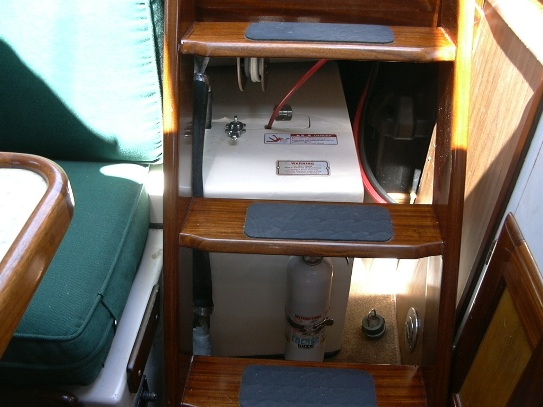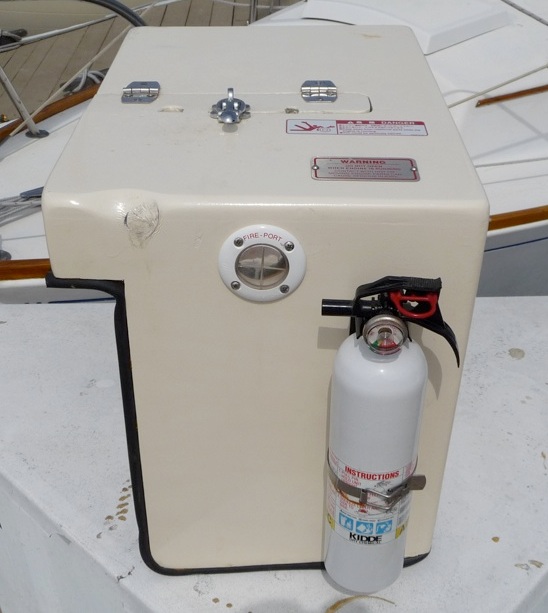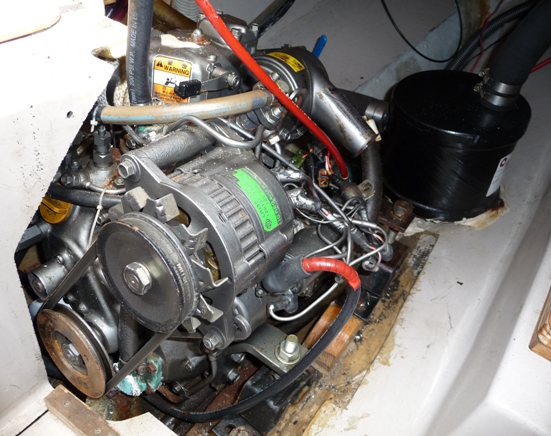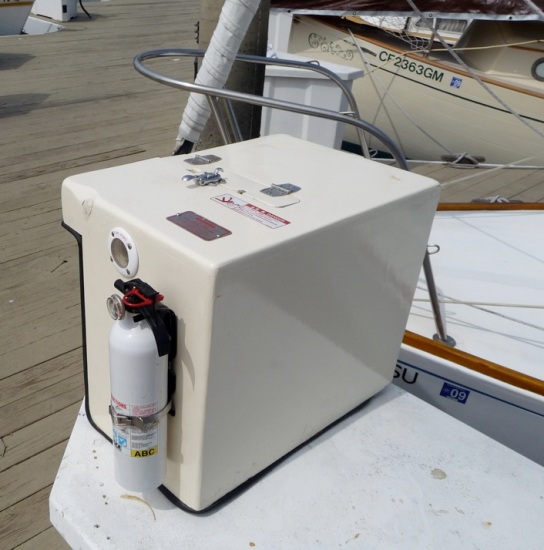|
Doug Pease's Aspara has a sweet looking engine cover and interesting comments about his power package. More pictures are coming.

The boat has an inboard diesel, a Yanmar 1gm10--the modern, high-revving version (3,600 rpm), which burns about a quarter gallon per hour at 2200 rpm. It's raw-water cooled, and pushes the boat remarkably well under all conditions. I carry ten gallons of diesel in the aft lazarette (in a steel tank—another project to contend with down the line), which gives me quite a bit of motoring range. The engine was done by a previous owner, but I've met the man who did the job; it was a feat of prestidigitation performed by Robin, at Del Rey diesel; there was a lot of cutting and pasting of the liner and the aft dinette seat, but everything glassed back together nicely, and with the carpet and the cushions in place, you'd never know how much was done (I'll take some pictures for your re-power section).
Until this year, I've had no issues with the engine, just oil changes and the occasional impeller, but three or four months ago she stopped pumping, and set off the temp alarm. After two long days of hose-chasing, I finally found the obstruction (typically, again, in the last place I looked; a little feed pipe from the raw water pump into the engine). The pipe was welded shut with calcium—a white concretion of masticated, heat-treated shells and tubeworms, probably ingested from the diver's scrapings inside the bronze intake thru-hull; I banged it out with a screwdriver, put everything back together, and pumped a bit of muriatic acid into the system. If you've ever done this, it's one of the nastiest jobs in boating—and alarming, too, as noxious, smoky fumes come billowing out the exhaust, giving the distinct impression that: 1) the boat is on fire 2) all the seals inside the engine are dissolving and 3) someone from the EPA will be arriving shortly have a little discussion and issue a citation. After a few minutes of the muriatic treatment (which dissolves the scale inside the engine), I hooked up the dock hose and pumped fresh water through the engine for about ten minutes. Not only did it begin pumping again, it pumped like it never has before. Next engine project, long overdue: a tee fitting with a gate valve, for fresh-water flushing.
I built a new cover for the engine three years ago; it doesn't do much for the sound, but it keeps the fingers and toes away from pulleys and belts, and it looks clean. The boat has a stainless shaft and conventional packing, a traditional cutlass bearing, and a little three-bladed prop. The fuel separator is mounted along the starboard cockpit wall, just behind the engine panel, and the controls are flush-mounted into the port cockpit wall. It's a very workable solution, and every time I start the diesel and motor away, I get a sense of satisfaction that I'm not squeezing a rubber bulb full of gasoline, or bending awkwardly to get a prop down in the water.
****************
March 22, 2009
Here is Doug's follow up email and promised additional pictures.
Ron,

I promised some pictures of Aspara's engine and cover 'The next time I took it off.' Well, we're more than due for an oil change, filters, zinc, etc., so here are some pictures of the engine and cover.

Aspara is powered with a Yanmar 1GM10 diesel, the modern, high-revving version of the old 1GM; it pushes the boat wonderfully and has never really let me down. It looks kind of ratty here--I guess the zinc is overdue. I will probably brush and paint the top while I've got the cover off.

You can see the intake thru-hull and the exhaust, and the conventional packing gland in the accompanying shot (Yes, I'll be cleaning up back there as well, while I've got things open...). The shaft is stainless.

Webmaster Note: This does not look like an amateur's work!!
The cover itself is made from marine ply, with some West System and a coat of Hatteras White linear polyurethane. The little hinged gate at the top allows for control cables and vent hose to pass through. The divot on the left front snugs under the swing keel cable hose. The whole thing is lined with sound baffling, but it really doesn't do much good; the idea was to neaten things up, and keep the fingers and toes out of the machinery...
Best wishes,
Doug
***************
February 6, 2011. For more on the Yanmar 1GM10 Diesel engine click here.
|
|
